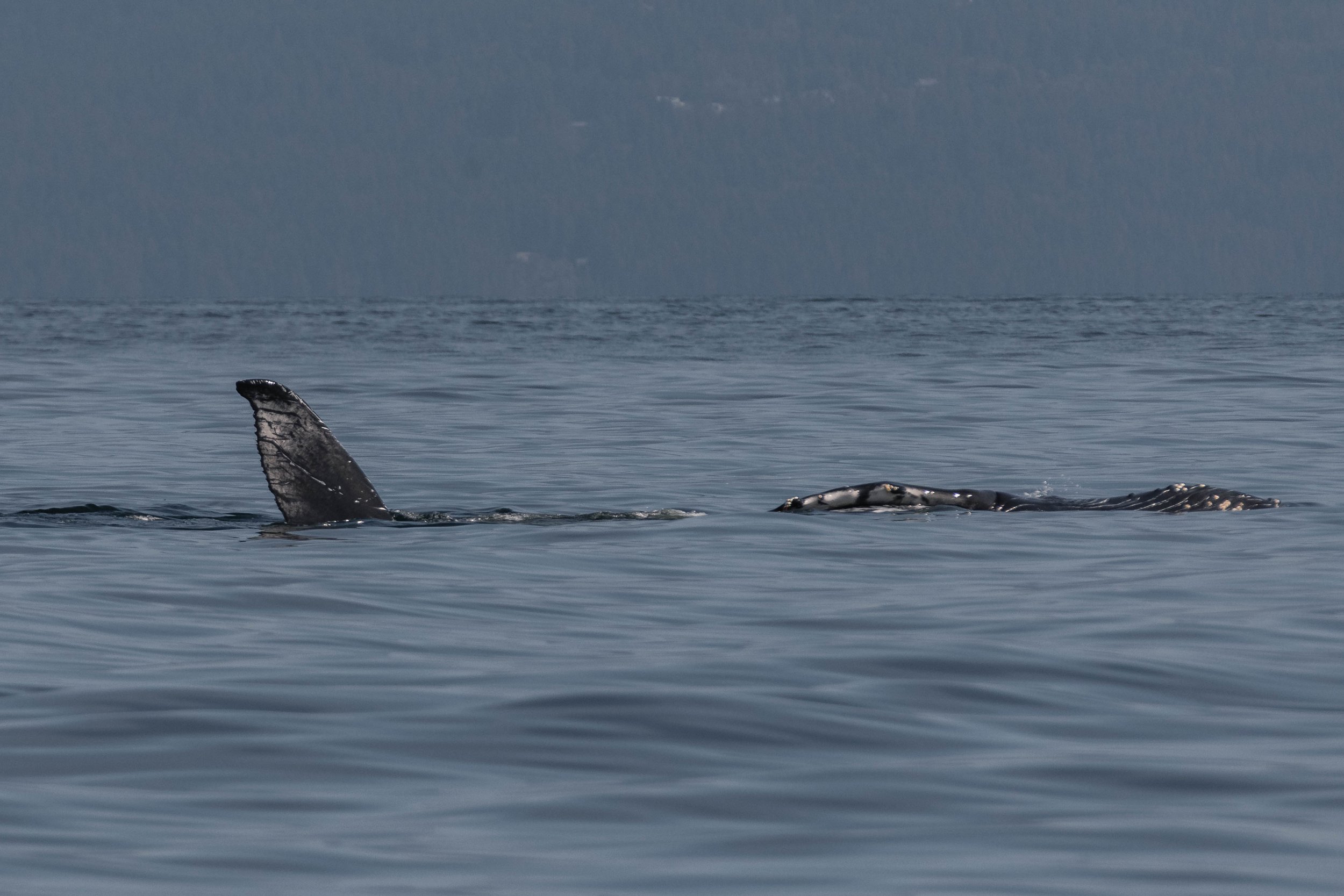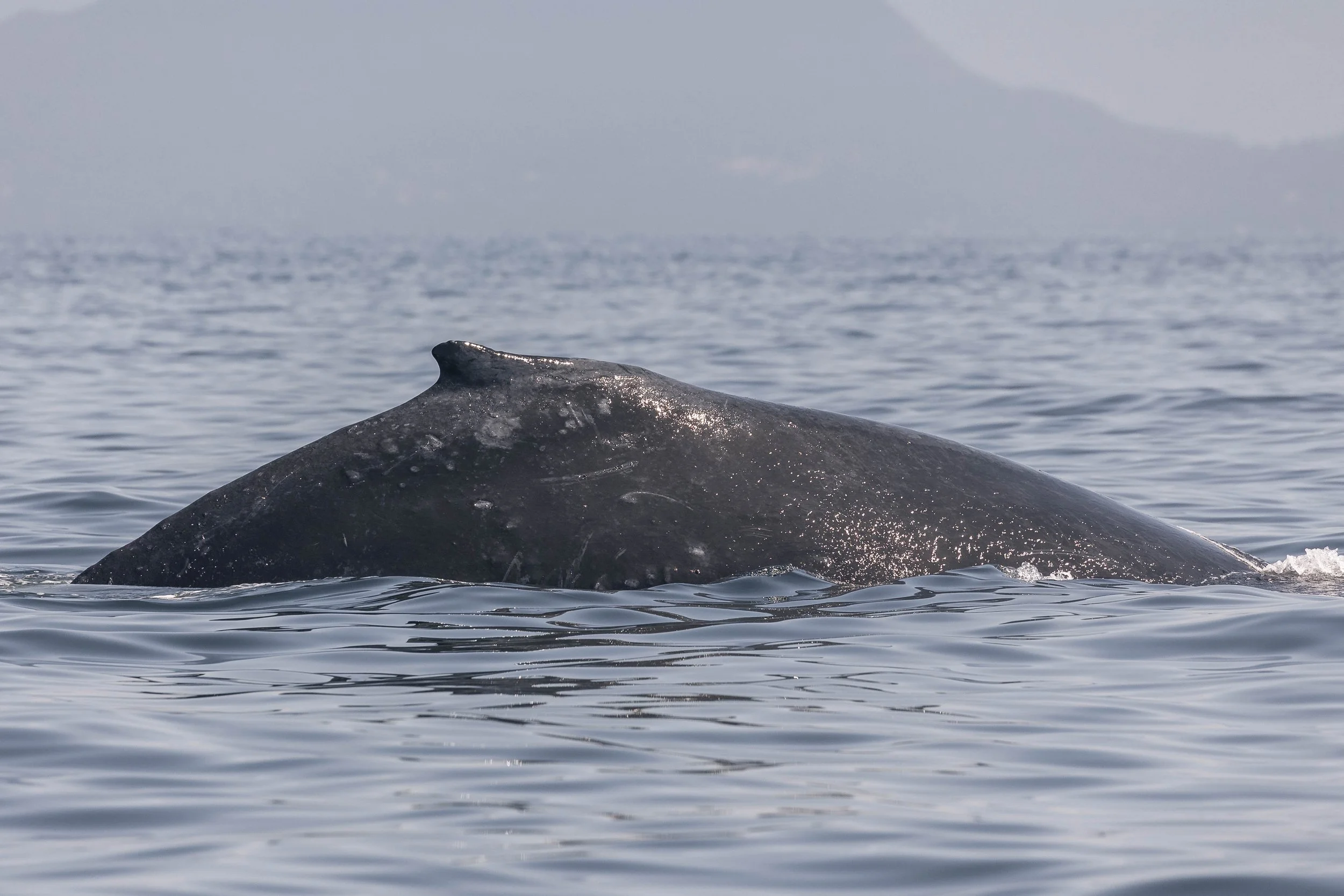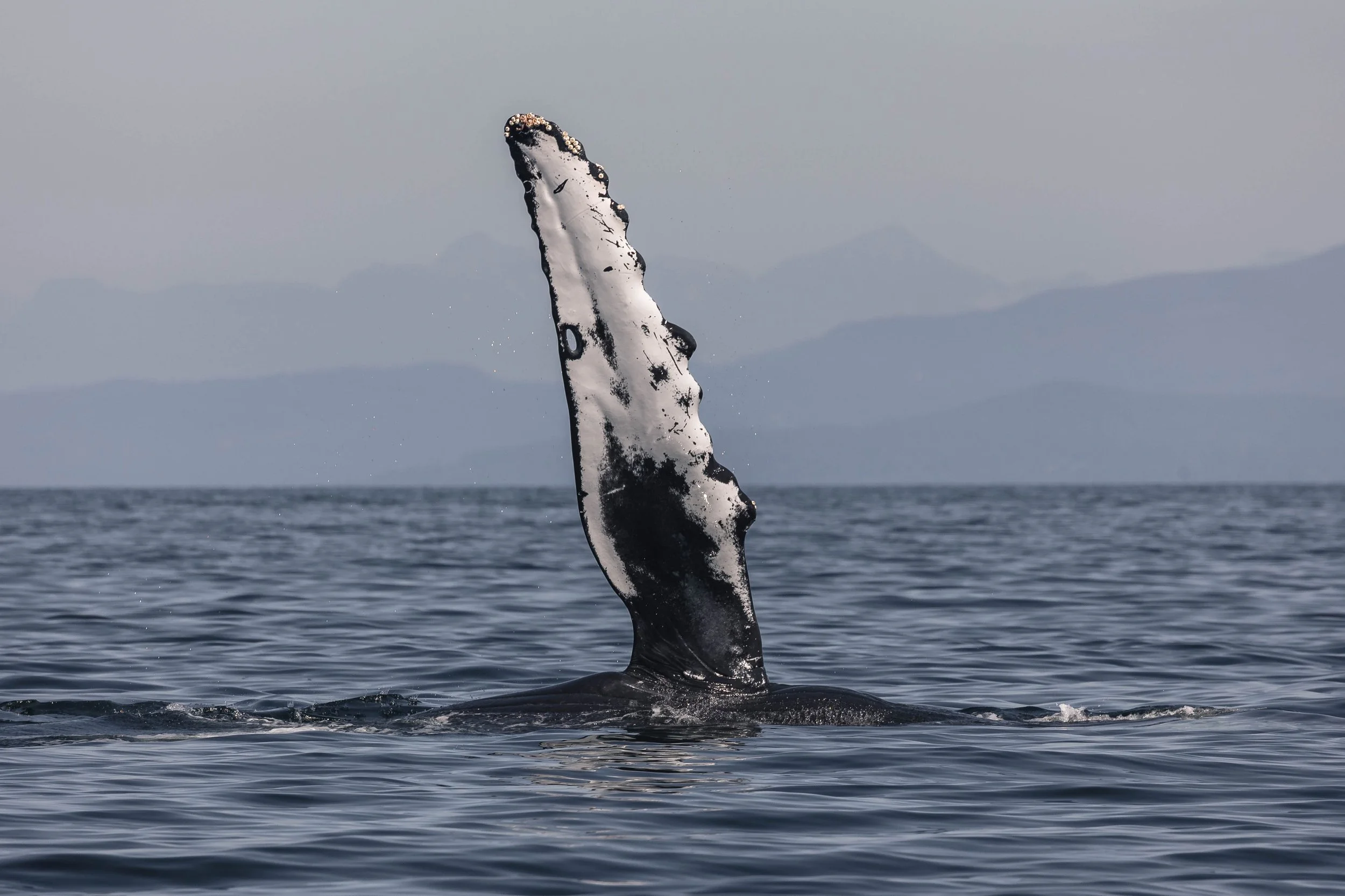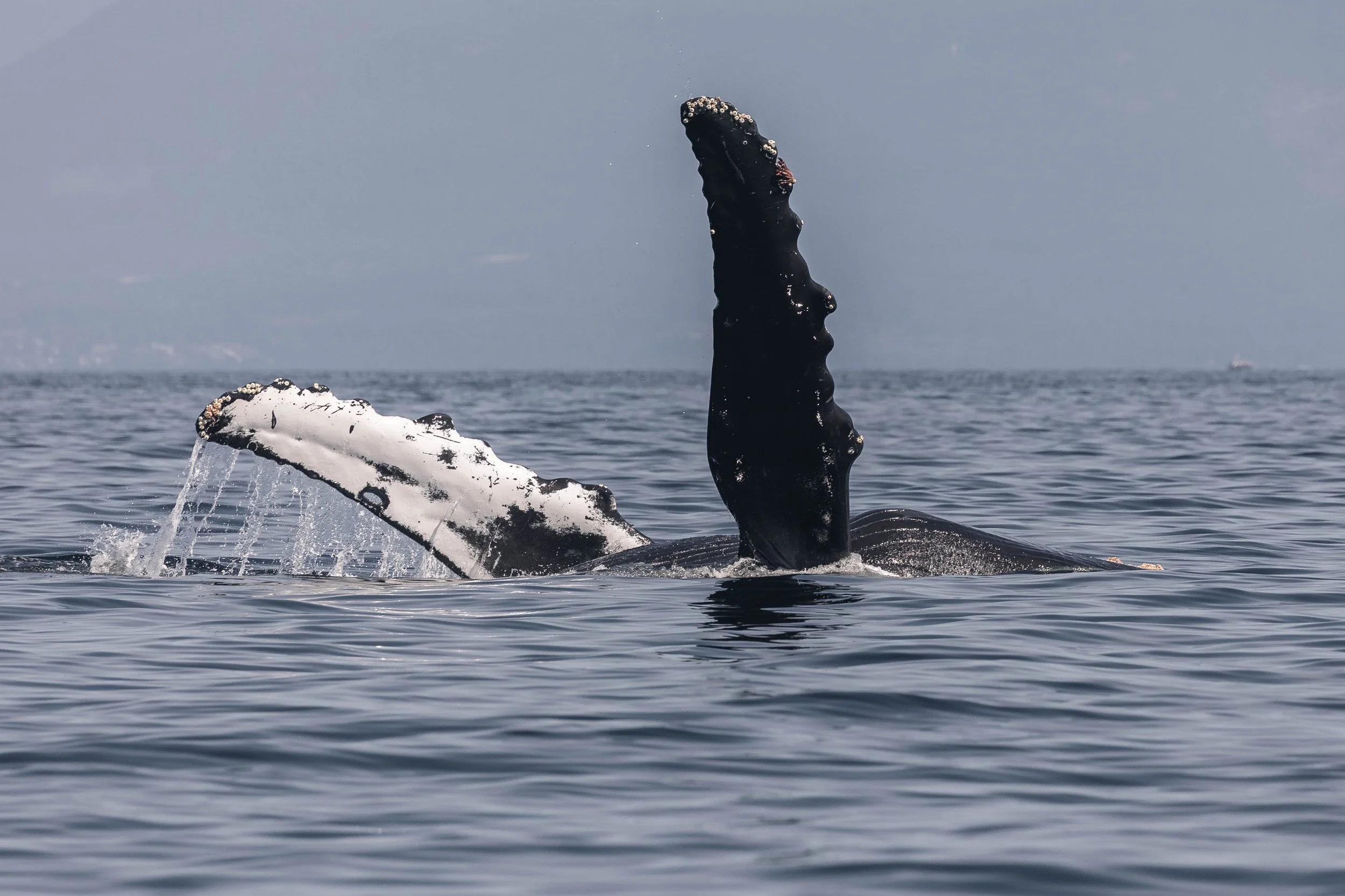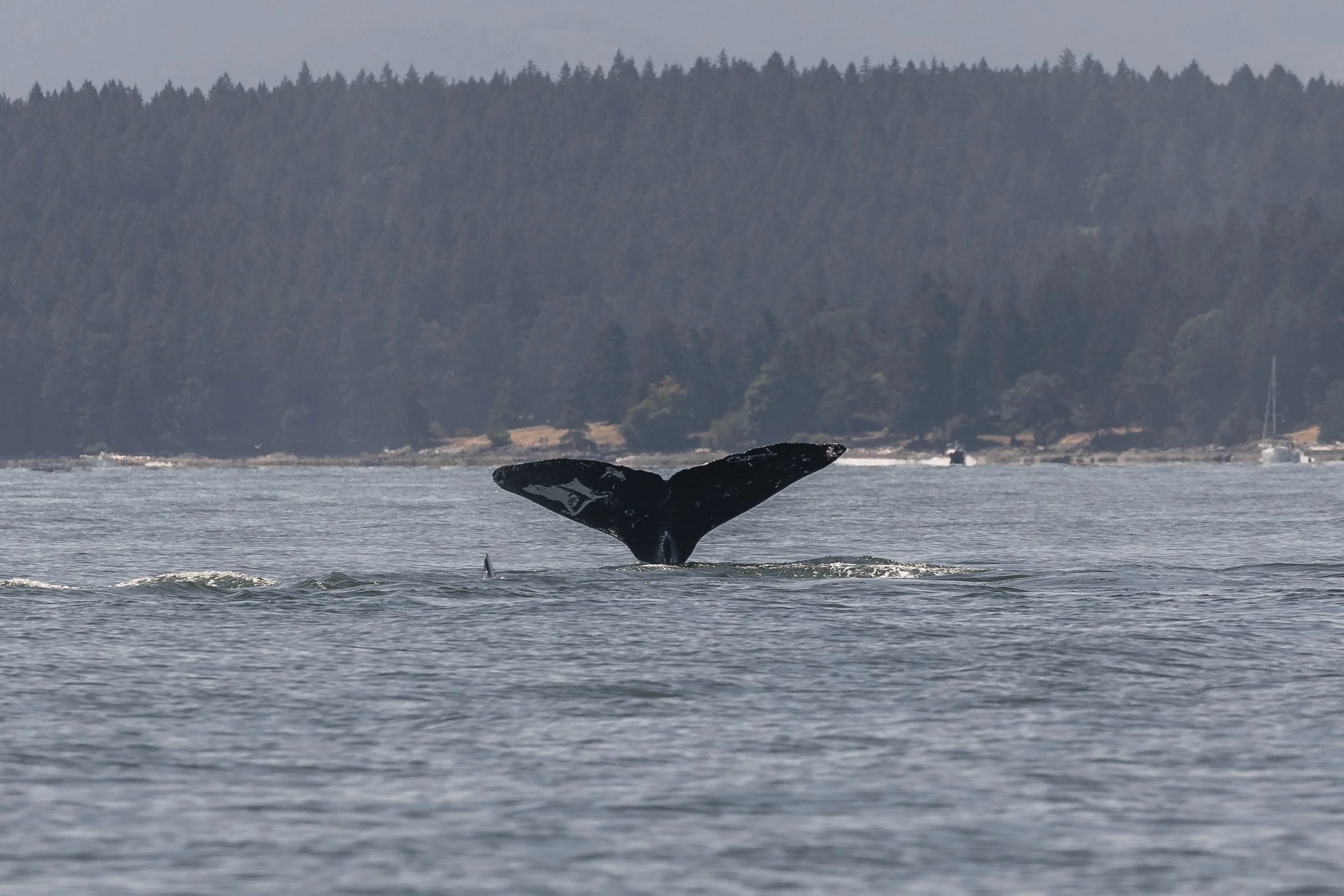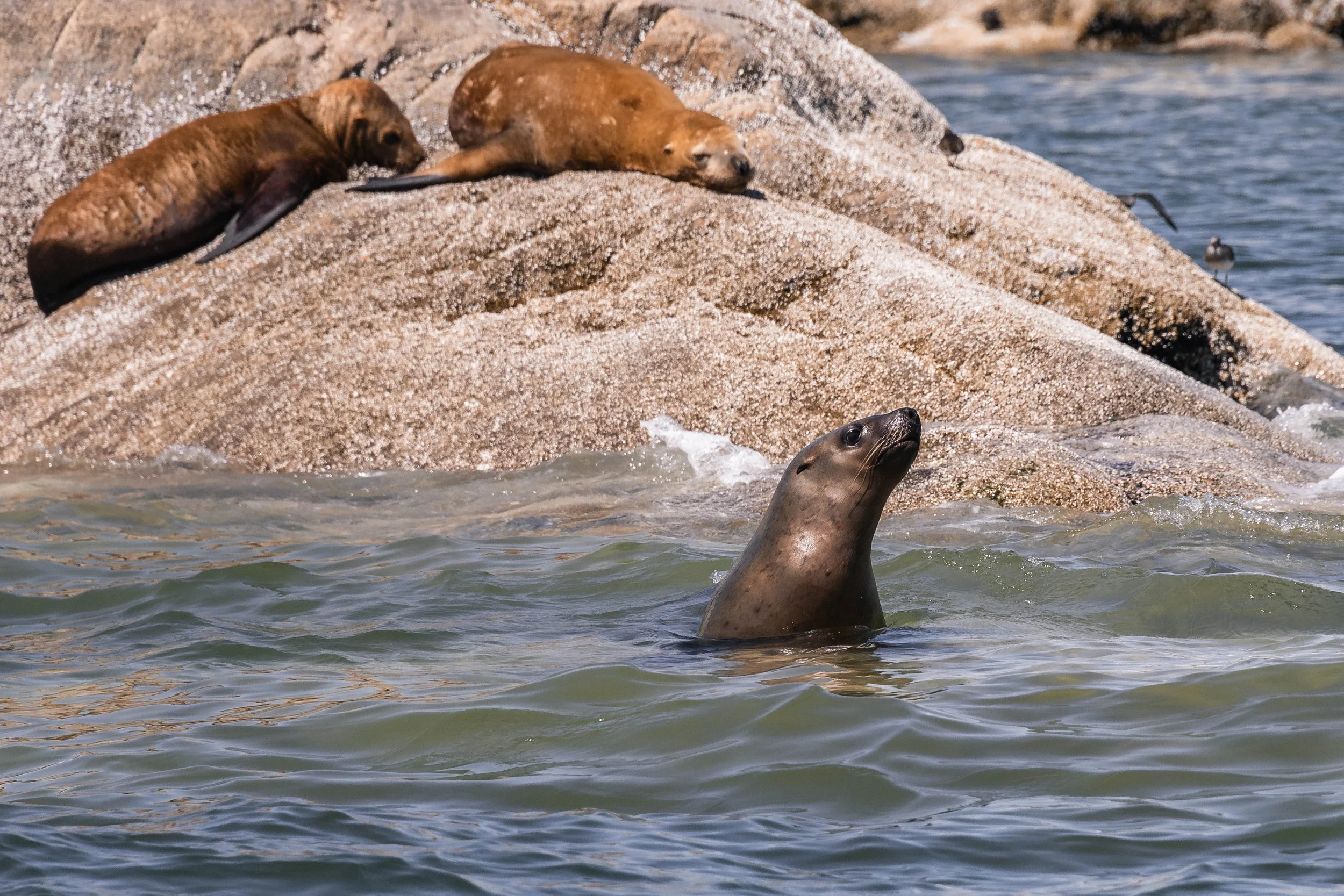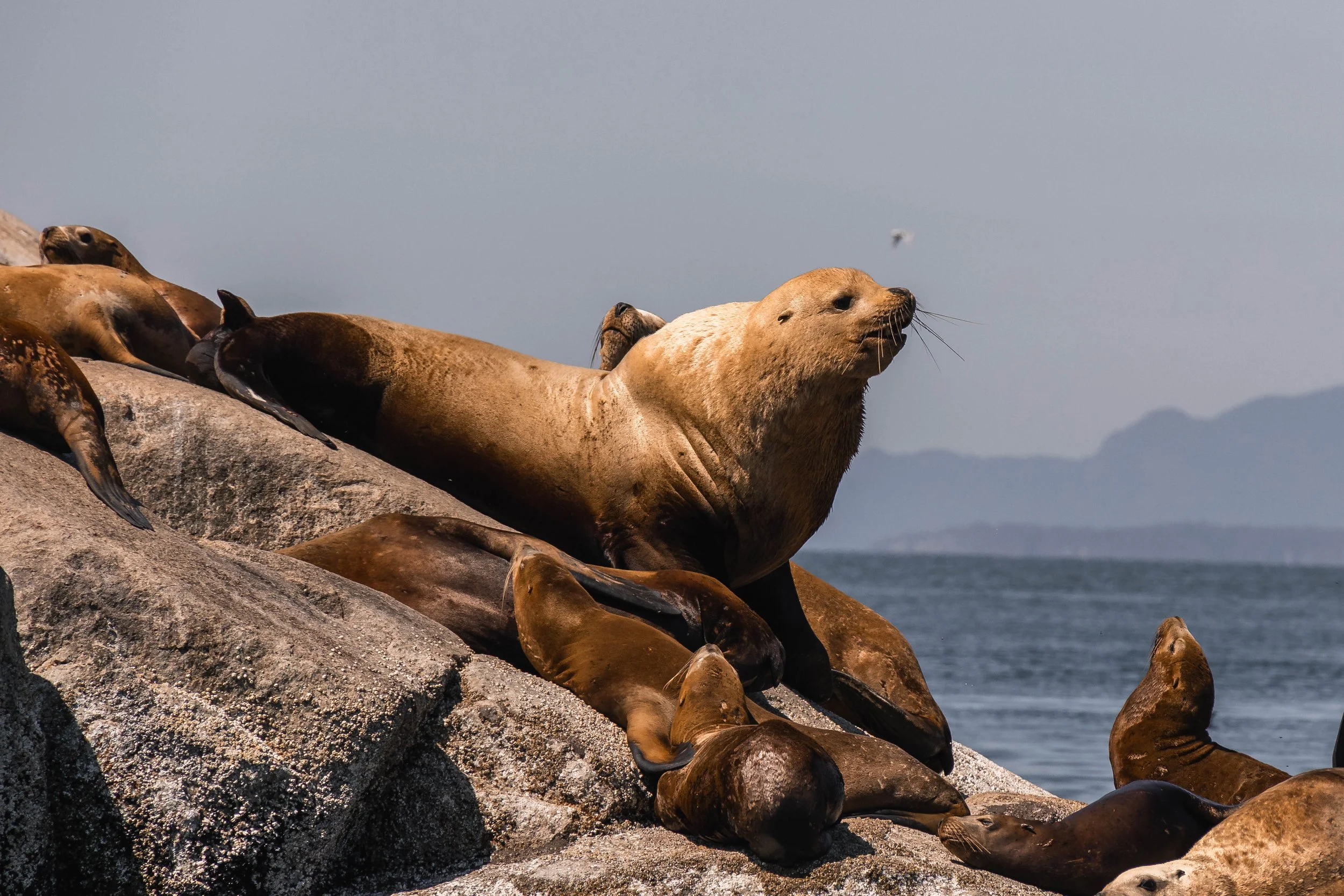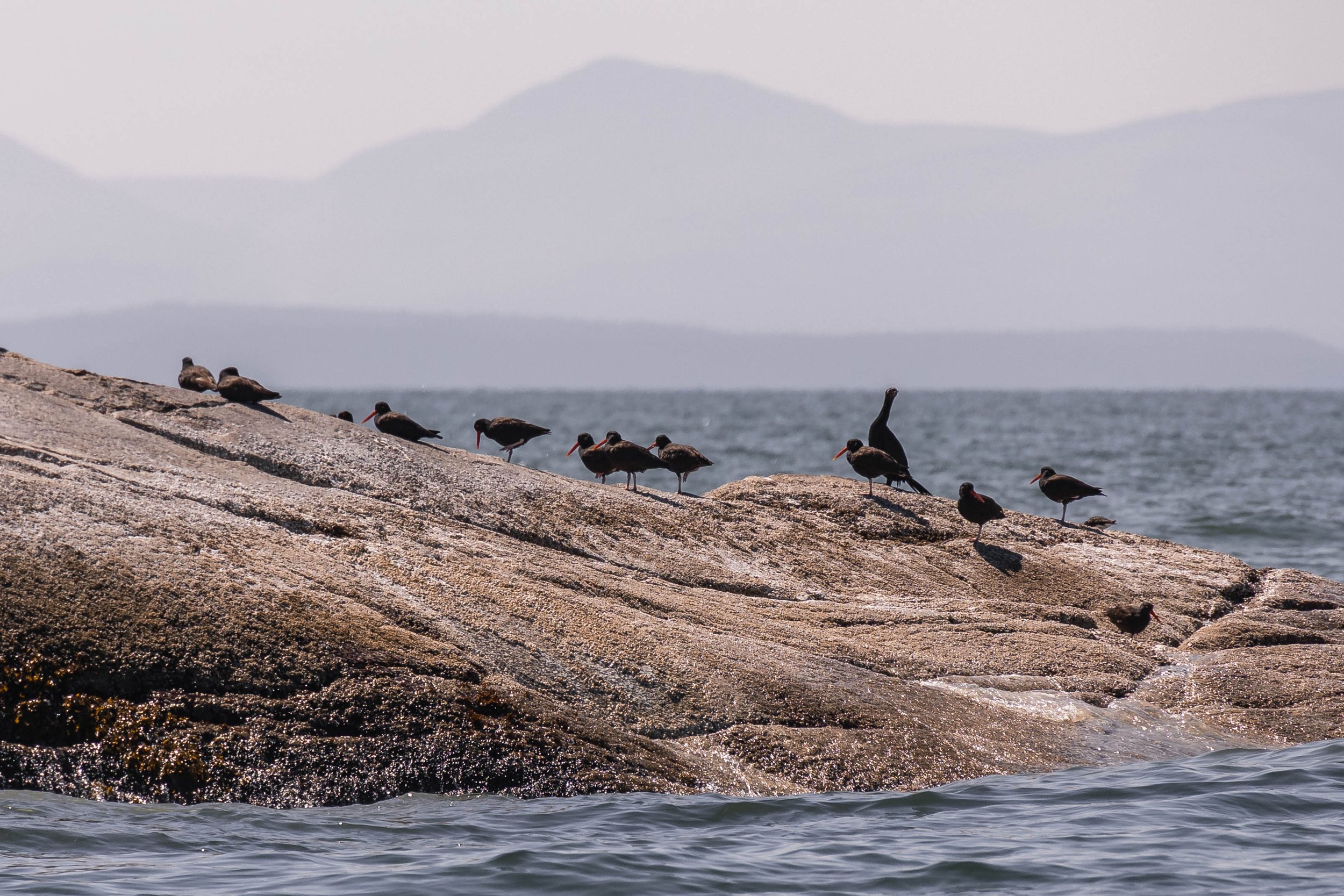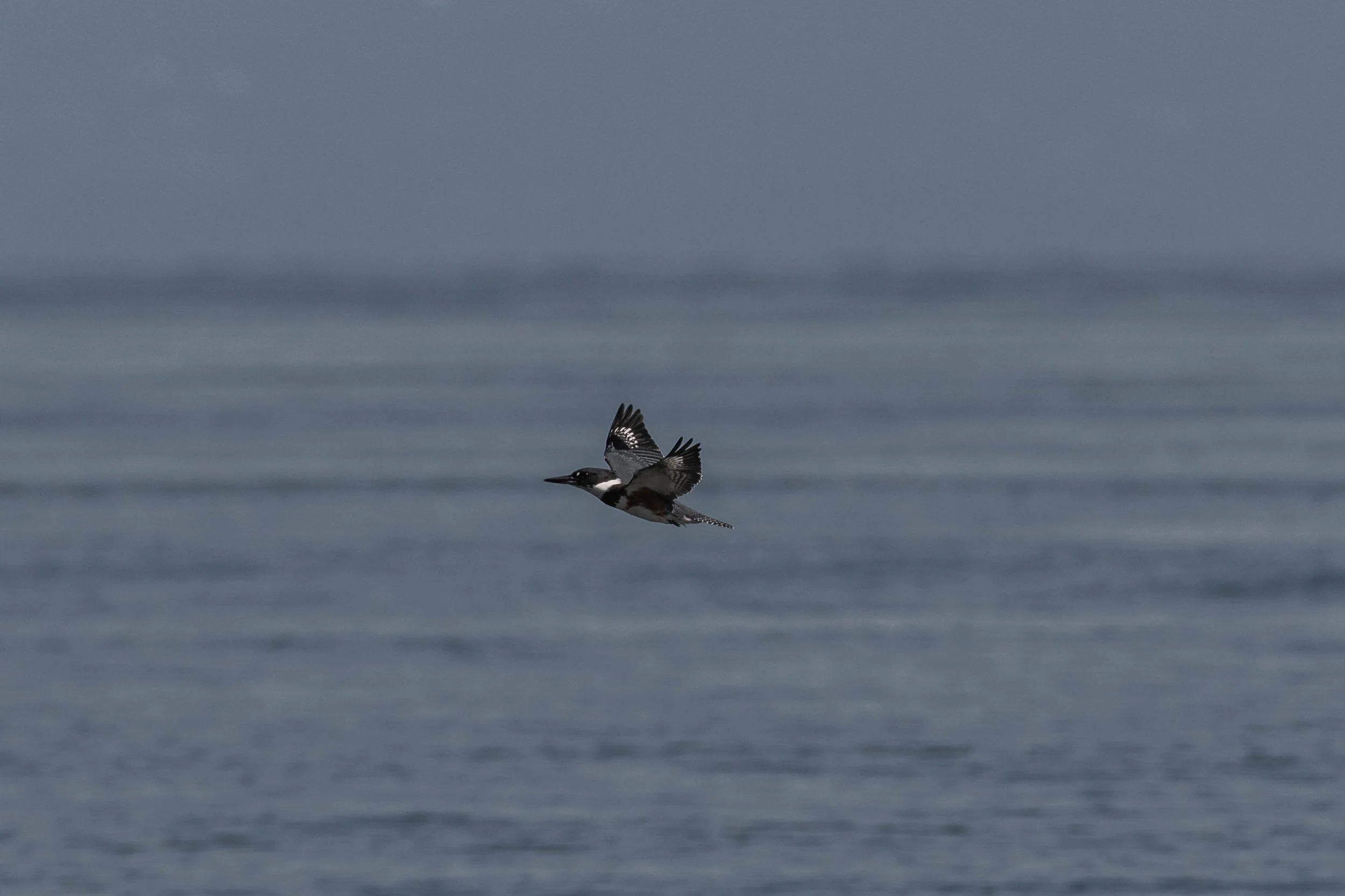July 30, 2025, 10:30 AM - Humpbacks as far as the eye can see!
We have been very fortunate this year, with a massive percentage of our humpbacks spending time just off of Gabriola Island’s shoreline, a mere 30-minute cruise away from our home port. Our vessels spread out to extend our sightlines as much as possible, scanning the beautifully calm waters, searching for whales for the day. This caused our boats to locate different whales at nearly the same time!
Our first whales of the day were found by our open vessel, Cascadia. Our second open vessel, Keta, quickly made their way over to join them as well. This pair were being very surface active, with some diving and fluking and interesting quite a bit of pectoral slapping! Pectoral slapping, also known as pec slapping, is a behaviour observed at the surface where a whale will lift its side fin (or fins) out of the water, slapping them on the surface. This behaviour is still a bit mysterious to us, as we aren’t completely sure why they do it. It’s speculated that pec slapping could be used for communication, as every slap at the surface causes huge sound waves to go thundering through the water. It may also be used to help dislodge barnacles or other debris from their skin, sort of like a ‘spa day’ for the whales. These gentle giants could also potentially do it as a form of play or to assert dominance over each other, which may have been what we were observing today!
After a couple of slaps and a few flukes, we identified our first pair of humpbacks as Hammer (BCY1222) and Professor X/Abyss (BCX1965). Professor X is believed to be female due to photo evidence and is at least 6 years old. Hammer is the 2019 calf of Claw, making them 6 years old, and their gender is currently unconfirmed. While we observed them, Professor X was seen repeatedly slapping beside and sometimes on top of Hammer. Hammer didn’t seem to be objecting too much, though, as the pair continued to travel side-by-side for the rest of our encounter. While we likely will never know Professor X’s true intentions during this observation, it was a very interesting behaviour to behold!
While the open vessels enjoyed Hammer and Professor X, our semi-covered vessel, Kula, had spotted a pair of humpbacks of their own. These two were travelling along, occasionally fluking and diving down. After snapping a few photos, this pair was identified as Kappa (BCX0158) and her 2025 calf. This calf has been ID’d in a non-conventional way lately, as it isn’t their dorsal fin or fluke we tend to see first. On their back, just behind their blowholes, this calf has a large cluster of barnacles, leading to them having a large white ‘patch’ that’s visible even with the naked eye! While these barnacles will eventually fall off, they will likely leave a large scar behind, meaning we may be able to identify this little one by this unusual marking later on in life as well!
After spending some time with Kappa and calf, Kula departed and made their way over to Hammer and Professor X, and watched them for a bit themselves as well. Keta departed the scene and once again started searching for more whales… and within 20 minutes, they had even more of them! Initially, there were two whales present, but this number shortly doubled, and suddenly there were four altogether!
The first pair was identified as Nike (BCX1377) and Vanta (BCX1730). These two seemed very curious, and they began to approach Keta. This behaviour, known as mugging, is always amazing to experience, but never encouraged. While it can be exciting to experience a whale ‘watching’ you just as how you are watching them, mugging can be a very dangerous behaviour for their health, as you never know how boaters may react if they are surprised by a massive whale suddenly appearing! Thankfully, these two seemed to move on from their antics relatively fast and went back to travelling and fluking. Shortly after that, they were joined by two more friends, who were identified as Smoke (BCX2183) and (BCZ0410calf2022). Once all four of these whales were together, they went back to very typical humpback behaviours, busily diving and fluking, likely hunting for some lunch!
Soon we had to say our goodbyes to our humpbacks and head out, eyes always searching in case there were even more whales nearby! The next stop of the day took the fleet around the edge of Gabriola Island, southbound to a little group of rocky islets off the coast of Valdez Island. Here, our Harbour Seals and Steller Sea Lions were soaking up the sunshine, enjoying the beautiful summer day. These rocks have lovingly been dubbed ‘Stinky Rocks’ due to the lingering aroma caused by all the hungry predators eating, defecating, burping, and flatulating from the tops of the rocks. If you brave the smell, though, you’re in for a treat, as you can see the Steller Sea Lions grumbling away and fighting each other for the best spots to sunbathe, and the Harbour Seals galumphing down the shorelines to pop into the water for a bite to eat.
After the excitement of the day, we had one more quick stop to make at another favourite wildlife stop that’s just outside our own harbour - the Gabriola Bluffs! While crossing over to the Bluffs, we also spotted a Belted Kingfisher zooming by. These nimble birds are often seen around the edges of Dodd Narrows, where many fish can be found near the surface, leading to perfect fishing conditions for these mighty birds. After approaching the Bluffs, we were greeted by a large gulp of Cormorants nestled together high up on the rocks. And on the very top of the Bluffs, a different kind of bird watched - we spotted a mature Bald Eagle as well as an immature Bald Eagle eyeing the waters up from above. Not only does this area have a ton of fish for the eagles to feast on, but having so many cormorants nesting here can also lead to hunting opportunities for these giant raptors.
Once we had our fill of time with the avians, we turned back to Nanaimo, cruising back into port after an incredibly successful day on the waters!
Please enjoy these photos taken by Marine Naturalists Aly Kohlman, Vanessa Vereschahen, and Hayleigh Hilbert!
Kappa’s dorsal fin. Photo by Aly Kohlman.
The dorsal fin of Kappa’s 2025 calf. Photo by Aly Kohlman.
Kappa lifting her tail for a dive with her calf close behind her. Photo by Aly Kohlman.
Kappa’s calf swimming sideways giving us a peek at their tail. Photo by Aly Kohlman.
Professor X’s dorsal fin. Photo by Hayleigh Hilbert.
Hammer’s dorsal fin. Photo by Hayleigh Hilbert.
The underside of Hammer’s tail. Photo by Vanessa Vereschahen.
Pecs up! Photo by Vanessa Vereschahen.
Professor X waving her pec around, with Hammer right beside her. Photo by Aly Kohlman.
Belly up, pecs out. Photo by Aly Kohlman.
Look at the huge hole in Professor X’s pectoral fin! Photo by Hayleigh Hilbert.
A nice, high fluke from Hammer. Photo by Hayleigh Hilbert.
The top of Hammer’s tail. Do you see the small hole? Photo by Hayleigh Hilbert.
Can you see the barnacles just below Professor X’s chin? Photo by Hayleigh Hilbert.
Backstroke anyone? Photo by Hayleigh Hilbert.
Hammer’s tail as they dive. Photo by Hayleigh Hilbert.
Those pectoral fins can get up to 18 feet long. Photo by Hayleigh Hilbert.
Professor X ready to pec slap poor Hammer. Photo by Hayleigh Hilbert.
Professor X showing off her tail. Photo by Vanessa Vereschahen.
Vanta’s dorsal fin. Photo by Hayleigh Hilbert.
Gooseneck Barnacles on the tip of Nike’s fluke. Photo by Hayleigh Hilbert.
Nike’s tail. Do you see the check mark that gave him his name? Photo by Hayleigh Hilbert.
Vanta’s tail. Photo by Hayleigh Hilbert.
The dorsal fin of Anvil’s 2022 calf. Photo by Hayleigh Hilbert.
A fluke waterfall from Smoke. Photo by Hayleigh Hilbert.
Smoke’s tail. The big white patch on their left fluke is an entanglement scar. Photo by Hayleigh Hilbert.
Anvil’s 2022 calf has a lot of barnacle scarring all over their body. Photo by Hayleigh Hilbert.
The tail of Anvil’s 2022 calf. Photo by Hayleigh Hilbert.
Photo by Vanessa Vereschahen.
Going for a dip. Photo by Vanessa Vereschahen.
Watching us, watching them. Photo by Vanessa Vereschahen.
A large male Stellar Sea Lion at the White Islets. Photo by Vanessa Vereschahen.
Harbour Seals in a banana pose. Photo by Vanessa Vereschahen.
A parcel of Oystercatchers. Photo by Vanessa Vereschahen.
A Harbour Seal mom and pup at Stinky Rock. Photo by Aly Kohlman.
A pair of pups. Photo by Hayleigh Hilbert.
A Belted Kingfisher flying by. Photo by Aly Kohlman.
Cormorants sunning themselves at the Gabriola Bluffs. Photo by Vanessa Vereschahen.
An adult Bald Eagle. Photo by Vanessa Vereschahen.
A juvenile Bald Eagle. They don’t get their white head and tail until they’re around five years old. Photo by Vanessa Vereschahen.




